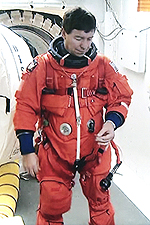To Our Ships
Greetings from the flight deck of the Space Shuttle Discovery, where today we celebrate our ships. The University of Houston presents this series about the machines that make our civilization run, and the people whose ingenuity created them.
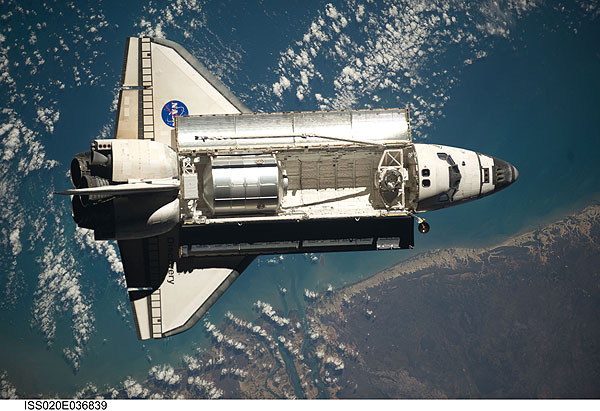
Discovery doing what she does best, approaching the International Space Station in late August of 2009. At that time I watched the approach from the ISS; this time will be the opposite, and I will be honored to fly aboard Discovery.
If you follow the rise of civilizations, you have to conclude that humans are not content to stay put. Find a population, a coast, and materials, and there is a history of ship building. Ancient world sea powers independently arose among the Egyptians, Minoans, Phoenicians, Greeks, and Romans, and this before 2000 years ago. These were followed over the next several centuries by the more far traveling fleets of Western Europe and China. In an interesting parallel, we now see the rise of independent space powers, with three nations able to launch humans and many more able to launch large payloads to orbit and beyond. It moves us to reexamine the place of ships in our history.
So much that defines us is reflected in our ships: first the primary desire to travel and explore, then the creative yet practical process of design, followed by organization of large numbers of people and resources to build a vessel.
Adapting to problems encountered and allowing for new technologies drive improvements in successive vessels. Art is added to design where and when possible, and we are naturally moved by the lines of a hull, the sail plan of a clipper, or a sleek airframe. What makes a ship effective in its environment seems naturally to appeal to our sense of aesthetics. Each vessel is a concentrated drop of the technology, commerce, art, and intentions of its time.
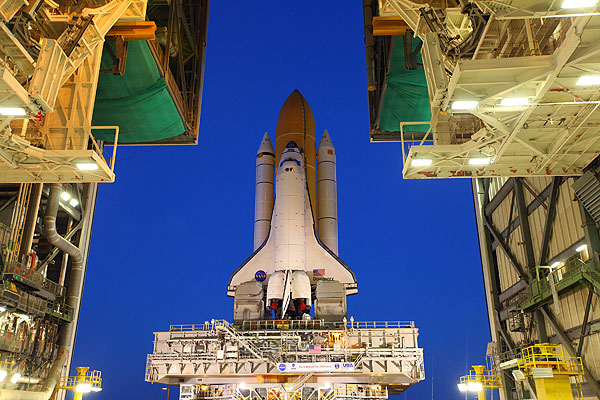
The Space Shuttle Discovery leaving the massive Vehicle Assembly Building at the Kennedy Space Center, on its way to the launch pad.
Rather than keep these treasures safe, we send them outward, mindful of risks but accepting that the benefits make the venture worthwhile. Ships have explored new lands, redistributed world populations and crops, and globalized our trade. Of course not all purposes have been pleasant and noble; ships have taken war to sea and to distant shores, carried slaves to the new world, and spread disease and vermin to pristine lands. Ships embody and transmit who we are, good and bad.
The ideas collected have revolutionized and at times polarized our thinking — Magellan's expedition which first circumnavigated the earth; Darwin's voyage on the HMS Beagle. To this one can only say beware voyages of discovery; they run the risk of turning the human perspective on life, nature, and our identity on its very head. But I like to imagine that the noblest purpose of our vessels is to explore, returning new knowledge to the betterment of us all. It is worth noting that our Space Shuttle fleet was named after great vessels of exploration.
This is the final flight of our good ship Discovery. It is a bittersweet time for us as we bring the age of the Space Shuttle to a close; bitter to see the end of this powerful, graceful bird's flights, as it must have been to see the clippers fade. But sweet, in reflecting on the wealth of knowledge we have accumulated, in the scope of human accomplishment, and in knowing that designs for new vessels are in work.
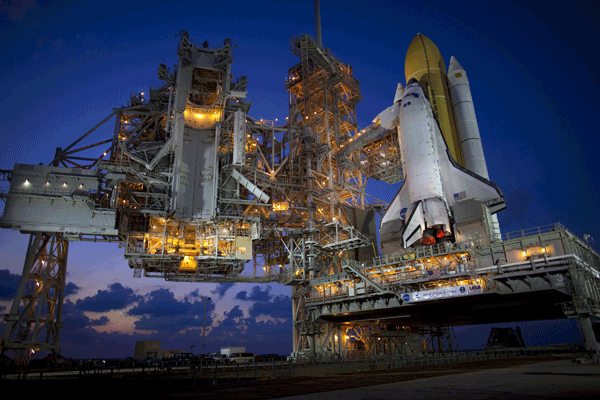
Space Shuttle Discovery on the launch pad. The large structure to the left will rotate into position around the Shuttle and place a clean room environment over the payload bay for final loading and processing before launch.
So here's to our ships, and to the men and women who build them, from those of us with the tremendous good fortune to sail and fly them.
I'm NASA Astronaut Michael Barratt for the University of Houston, where we're interested in the way inventive minds work.
Endnotes:
As noted in the audio episode, our Shuttle fleet was named for ships dedicated to exploration. The rich maritime history of Great Britain supplied most of these, and the Space Shuttle Discovery owes her name to many storied forbears.
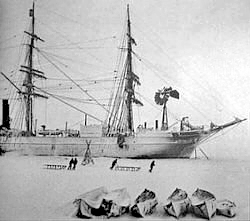
The RRS Discovery, which carried Robert Falcon Scott and Ernest Shackleton to the Antarctic in 1901; she would spend three years along the southern continent, much of that time trapped in sea ice.
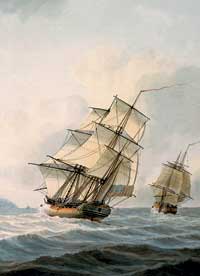
Resolution and Discovery, used by Cook on his 2nd voyage. Both were built in the Whitby shipyard in North Yorkshire. Discovery started out as a stoutly built collier named Diligence before being acquired and refit by the British Admiralty.
Henry Hudson's Discovery was a tiny vessel used to explore what would become Hudson's Bay and search for a Northwest Passage in the early 1600's.
One of the sturdy Whitby colliers used by Captain Cook on his 3rd and final voyage in the 1770's, captained by Charles Clerke, was also named Discovery. The Hawaiian Islands were discovered on this voyage. One of Cook's midshipmen, George Vancouver, later went on to command another ship bearing the name on a voyage of exploration to the Pacific coast of North America from 1791 ' 94.
Yet another Discovery, commanded by Robert Falcon Scott, explored the Antarctic at the turn of the 20th century with an unprecedented focus on the geography and science of the polar continent.
The keel of our own Discovery was laid in 1979 as construction began on the crew module, and she took her maiden flight in August of 1984. Since then she has become the fleet leader — this mission is her 39th and at landing Discovery will have accumulated about a year in space. Discoveryhas launched and returned satellites from space, lifted the Hubble Space Telescope into orbit, and played a major role in the construction of the International Space Station.
Looking at the heritage of the name Discovery, along with the legacy of its space-faring namesake, the most exciting question is this: What will be the next ship of exploration to bear the name?
References:
For a brief history of Space Shuttle Discovery's history see the Wikipedia and NASA web sites.
Both images, RRS Discovery and the Resolutionand Discovery ocean vessels are from Wikipedia.
All Space Shuttle Discovery photos are courtesy of NASA.
